Rob & Georgia Buchert
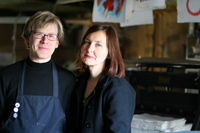
How did you get started in letterpress and book arts?
The whole fine press enterprise really started with a good marriage and a desire to work together. We were young newlywed students, looking for our own path. Rob studied journalism and worked at our college newspaper. He had experience in visual arts and put it to use doing design work as well as writing for the school weekly. His want of formal training prompted him to spend many hours at the library studying design. He discovered the art of typography and found his second love: letterforms.
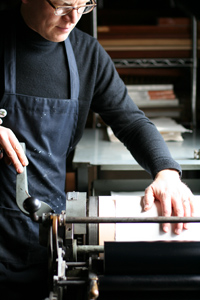
We became familiar with a man named William Morris, a nineteenth-century artist, author, and interior designer who, near the end of his life, decided to set up a press and print beautiful editions of texts he believed were significant. His work was exquisite and his ideas inspired us. We shared his aesthetic and his passion for books, and eventually we decided to try our hands at making them as Morris did, the old-fashioned way.
We put school plans on hold and set our course for the unknown. We purchased a monstrously large orange work table at Deseret Industries for $8.00, and with a few linoleum-cutting tools and some space commandeered in the communal basement of our apartment building, we declared our independence and called our endeavor Tryst Press. Within a couple of years we found presses, type, and all the other things we needed to print books.
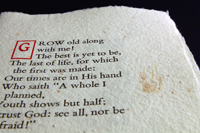
We got our start at the perfect time. Not long before, there had been a dramatic technological shift in the printing industry, and as a result all the equipment we were interested in was considered obsolete. It seemed we could have as much as we wanted, often for no more than the price of hauling it away.
Also providentially, Doug Himes, who taught printmaking at BYU, had taken an interest in letterpress and had acquired presses and type for use in the art department. He invited Rob to sit in on his class and learn the basics of presswork and typesetting. Rob now teaches his own class called “Type as Image” at BYU and uses that same equipment, almost twenty years later.
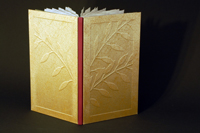
From there, how did it grow to where it was viable and you were making a living?
As we learned to use our new equipment and create with a new medium, Rob took a part-time job with a private college; he ran their Macintosh computer lab and did design work for the school. Once we gained some proficiency with letterpress we began soliciting job work—wedding announcements, business cards, letterhead, and such. We also kept our eyes open for new and exciting rice and bean recipes—in those early days we relied heavily on our food storage and the blessings of living the law of tithing.
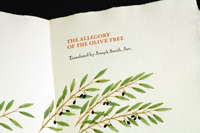
We can’t say it too strongly: the timing for this venture appeared to be heaven-sent. After the “death” of letterpress in the commercial market, there began to be an interest in the modern design community to resurrect this archaic craft. As far as we knew, we were the only letterpress printers for something like 500 miles around who understood current graphic arts technology. That was a profitable arrangement for us at the time. After two years Tryst Press became our full-time employment. Job work provided bread-and-butter money as we learned about making and publishing books.
A big part of becoming successful is simply sticking with it. Bookmaking has more in common with architecture and symphonic composition than it does with painting or printmaking; so many varied elements must be orchestrated and built upon one another harmoniously. Each project can take months, sometimes years. You can’t absolutely predict the outcome of a book, whether it will flop or do well; you find out how successful your creative efforts have been only after you’ve turned the final page, so to speak.
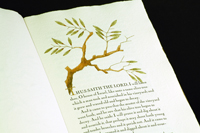
How did you learn your craft?
Soon after we started Tryst Press we made a list of the elements of fine press bookmaking that seemed important to master: book design, type design and manufacture, papermaking, illustration techniques, letterpress, bookbinding, and publishing. Generally, we took these on one (or two or so) at a time and researched, experimented, researched, and…researched.
Over time, keys were given to us that unlocked doors of understanding. We live in Provo, Utah—and while this seemed a hindrance in the sense that for hundreds, even thousands of miles, we could find no one to learn from who had the level of proficiency we were looking for—our location was also a blessing because of our proximity to the BYU library, which has exceptionally good collections on all of the subjects in which we were interested. We’ve already mentioned Doug Himes’ kindness. Another friend, Chris McAfee, was an MFA student in Book Arts at UA and shared with us a new process which made it possible to print with a letterpress, artwork designed on computer. The Internet began to blossom soon after our journey began and that made it possible to connect with experts in distant places.
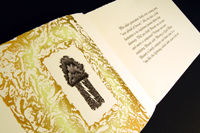
We’re mostly self-taught…and in some cases maybe hyper-taught. Out of necessity we’ve made many of our own tools, which have required extra research and uncommon skills. A good example is papermaking: to make enough consistently high-quality paper in-house for printing an edition of books, we needed professional handpapermaking equipment. The making of those tools is itself a “lost” art…a long, painstaking process Rob lovingly learned because it was the only way to get precisely the result we were after. Here’s another example—wood engraving was once a common technique for illustrating books and magazines, but the last professional wood engraving block manufacturers died or went out of business years ago, and the best woods for the process are extremely scarce and don’t grow in North America. Rob worked hard to uncover sources and then researched and re-invented manufacturing techniques so he could produce the materials we needed. A little expertise goes a long way; for a while we ran a small side business called Wood Engraving Supply, and were actually the only wood engraving block makers in the world.
Can you walk us through the process of making The Allegory of the Olive Tree?
As publishers and artists we’re always exploring ideas for new projects. We want to work with what interests and is important to us—what we love. We are both students of scripture and its rich symbolism, and so this gem of an allegory, Jacob 5, which is unlike any other passage in Restoration scripture, suggested itself as a wonderful project and a great opportunity to invest creatively in some Book of Mormon text that we love. The entire chapter is explicitly a metaphor, one that tells itself slowly. It’s beautiful.
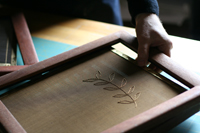
Author, editor, and BYU professor of Linguistics and English Language Royal Skousen is a friend of ours. When he found out what we were up to with the allegory, he volunteered the use of his critical text, which we accepted.
Deciding how to present that text was the next step. Everything about a book ought to revolve around the text. There are always considerations about the size of the book, the number of copies, placement of the text on the page, typefaces, embellishments, suitable papers, colors, textures, binding style, and so on. Designing a book is not a linear process. It often includes some happy accidents. Always it involves testing concepts and combinations, hammering them out, accepting, rejecting. For example, the question of embellishment—illustration vs. decoration—part of the designer’s job is to present the text as appealingly as possible. We embellish a text to add interest to a page. Illustration is a parallel telling of the story. Decoration, on the other hand, may reference the text but makes no overt attempt to visually interpret it. Illustrating scripture is difficult. Most scriptural illustration adds too much interpretation and can distract a reader from the personal revelation that might come by simply reading with the Spirit. For that reason, we decided on decorations only for this book.
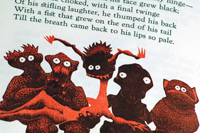
After that decision came the question of how and where to decorate. The allegory beautifully describes two interwoven patterns—the natural cycle of the development of fruit, and the rhythm of careful, patient husbandry. The book’s decorative motif became olive branches bearing fruit in various states of maturation. These clearly referenced the text but imposed no interpretation. Initially Rob planned to letterpress these decorations but realized that printing couldn’t give the effect we wanted. Our intent was to mimic one of the most beautiful pictures in existence of an olive tree—from a 4000-year-old Cretan fresco. The only way to achieve that kind of look was to paint, by hand, every decoration in each of the books, in an edition of fifty. Ultimately this choice proved to be serendipitous; the hand technique echoed that used to create early biblical illuminations. Rob painted the images using pigments ground from rare earths and gemstones chosen because, like the sacred words they were used to embellish, they will not fade. A study of the text made placement of the decorations easy; there are four distinct sections in the allegory, and the spaces between were ideal for depicting the ripening of the olives.
As we deliberated over what kind of paper to use, it seemed that as long as we were already investing so much extra energy into the book, we might as well keep going and make a special paper and include a unique watermark (again, an olive branch). Our friend Thom Hinckley gave us some lovely old mahogany which Rob cut and used to build papermaking equipment specifically for The Allegory of the Olive Tree. Soon afterward, Thom revealed that the wood had come from the salvaged beams of a villa constructed for one of Christopher Columbus’ sailors. The Jacob 5 allegory symbolizes the scattering and gathering of Israel. Columbus’s arrival in the Americas is considered by Latter-day Saints as a pivotal event leading up to the Restoration and, consequently, the gathering of Israel. Repurposing (inadvertently) the lumber from the home of a key player in that event to make paper for our book was a sweet bit of serendipity.

The typeface is an early twentieth-century design based on the intaglio inscriptions of a seventeenth- or eighteenth-century French engraving master. A friend in West Virginia happened to have one of the two existing sets of matrices (the brass molds used to make metal type), and another friend in Maryland agreed to cast it for us as a trade for some custom papermaking equipment. The face looks arboreal, like branches and twigs—another reflection of the text. Rob set the type by hand, one letter at a time, then proofed it—made a trial print from the newly set type to be passed back and forth between us and checked for spelling mistakes, upside-down letters, correct spacing between words, and a generally pleasing shape of text block. We corrected, re-proofed and re-corrected it. After the typesetting passed its final inspection, Rob dampened the paper in preparation for printing because damp paper receives ink better than dry paper. Unfortunately, we only had enough type to print eight pages of the book at a time. After each set of eight was printed, the type was broken up and reset for the next eight, and again proofed, corrected, re-proofed, and so on, until all the pieces of the book were printed and the dampened paper allowed to dry. This process had to happen with some haste because damp paper left too long will begin to grow mold.
We would have loved binding the entire edition in olive wood, but after a year and a half of searching the country for boards of the right dimension for book covers we managed to find only enough for eight copies. We hired our friend Ethan Ensign, who runs Scrub Oak Bindery in Salt Lake City, to bind the olive wood copies. We bound the rest of the edition ourselves, with leather and gold silk covering book boards decorated with raised designs of olive branches. The gold silk was a reference to the plates from which the Book of Mormon was translated.
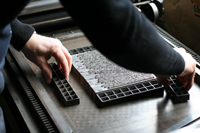
Is your work all your own projects or do you do commissions as well?
We don’t take on many commissions. Generally speaking, that’s not where our interests lie. By the time we’ve finished a commission we may have spent more time with the text than the author did. We’re open to them, but we’re picky. We’re far more interested in producing our own projects and in collaborations.
What’s the market like for the work that you do?
It depends on the book. Some projects we know from the outset will sell more easily than others. Obviously marketability must be a consideration for us, but it can’t be the main one. We don’t plan our books with a target audience (other than book or art lovers) in mind. One of the reasons why winning the Hertzog Award for The Allegory of the Olive Tree was so sweet was that the award is completely outside the context of the LDS community, which we guessed would be the natural market for this particular book. Every one of the judges and others besides asked questions about the text. It was very gratifying that the award opened up even little conversations about why the text is important to us.
Our work is in collections all over North America and Europe. Academic and public collections form the base of our market, but we have a growing number of private collectors purchasing our work.
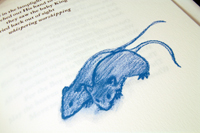
What’s your favorite part of the work?
Rob’s favorite part hands-down is conceptualizing. That’s the most dynamic, creative, and appealing part of the work. Everything else is production. Georgia agrees, but insists that there’s also a great deal of satisfaction in being able to enjoy the finished project, share it with someone else, and then clear mental and physical space for the next round of creating.
What’s your least favorite part?
Generally speaking, the repetitive aspects of production: i.e., feeding the press, feeding the press, feeding the press. And bookbinding. But there are times when these can be meditative and enjoyable.
How many projects do you have going at a time?
Probably too many. Right now we’re actively working on three big projects: The Book of Ruth, with our friends Brian Kershisnik and Richard LaRay; Robert Maxwell’s new translation of the thirteenth-century Prester John’s Letter; and the Book of Isaiah. We also have a number of other possibilities trying to find their way into reality.
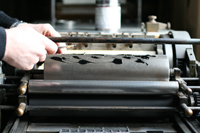
How do you see the gospel affecting what you do?
How could the gospel not affect what we do? The work we do isn’t inherently important. There’s nothing important about an expensive limited-edition book. Not even an expensive edition of part of The Book of Mormon. Paradoxically, it’s also extraordinarily important for us because this whole endeavor has been a vehicle for change and growth and learning, for the Lord to teach us some important truths. It’s been a way for us to share and have interactions with some great people. Another way to ask that question could be, “How does the work you do affect your relationship with the gospel?” Hopefully anyone’s work can provide a fulfilling way to learn and improve; if it doesn’t, then there’s something wrong inside the person or there’s something wrong with the work.
It’s validating to do something creative for a living, and especially rewarding to get to do it together. We’ve both found it heartening to come to understand that our Father in Heaven takes pleasure in our efforts, and is actually excited for us to use our talents and exercise our dreams. We are all intended to be creators of one kind or another. Sadly, it’s not everyone’s blessing to have a job doing something he or she naturally loves, but so many more people could choose that path with a little direction, some courage, and a determination to make the necessary sacrifices.
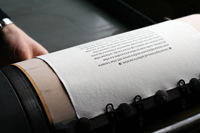
Doing these creative things—finding ways that work for us to support our family, whether or not what we produce is considered important—has brought us and occasionally other people joy. Learning joy is central to everything. When we’re joyful ourselves, we’re of greater use to our world, we’re better examples, and what we have to offer becomes more appealing to others.
Because we live in Utah County, the marriage capital, people regularly come to us with wedding announcement jobs, and sometimes they’re a little unhappy about the cost of letterpress. Not that it’s astronomical; they just don’t come with a frame of reference. Any price we could name would likely be more than they would think it should be. In that situation either of us is likely to respond to our clients by saying, without irony: “This is a luxury. It doesn’t matter. This stuff isn’t important.” This attitude has grown over time from of an understanding of the gospel and what life is about. It can be easy to view what you do as so big and so important—or if it’s not big, to wish it was and then try to make it that way. The gospel helps us gain and maintain perspective on what our work really means. Here’s paradox again—“I’m nothing, but I’m also everything.” Seeing ourselves in the larger picture may leave us feeling small and foolish, yet there is an actual God who loves us, loves our gifts, and wants us contributing what only we can, because that will increase the light in our own lives and in the lives of those we touch. His gospel inspires us to strive for excellence in work and spirit so that we can achieve and influence happiness and be effective in His kingdom.
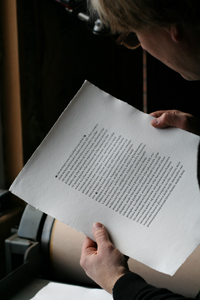
There’s been prophetic and apostolic counsel given to LDS artists: we should be producing the very best work. What does it mean to become the best in the arts? Probably not what we think it does. As Latter-day Saints we can’t and shouldn’t compete in many of the arts of the world today, but we ought to challenge culture—our own culture as well as popular culture. The way we will become the best is by redefining what is best, not by allowing the world to dictate the standard, particularly a world declining in its morals, values, norms, and its designation of what is artistic.
There are many LDS artists who fall into the trap of attempting to play by the world’s shifting rules and hoping to come out winners. As individuals and as a community we need to examine our orientation. We need to seriously ask, “What is the best? What are we willing to participate in?” We can never be the best of what the world currently asks for while staying true to our faith, because generally the world no longer calls for virtue, but we can become the best and make great contributions if we work within the paradigm of the gospel. “Is this morally sound? Does this uplift?” Are we examining the questions of humanity, within the context of the gospel? Are we inventing new art forms to house the answers? All of this is within our rights and our reach. We have to change our culture; that’s the only way we’re going to fulfill those prophetic admonitions. As artists we have the greatest opportunity of almost anyone to do that, because we invent culture. ❧
